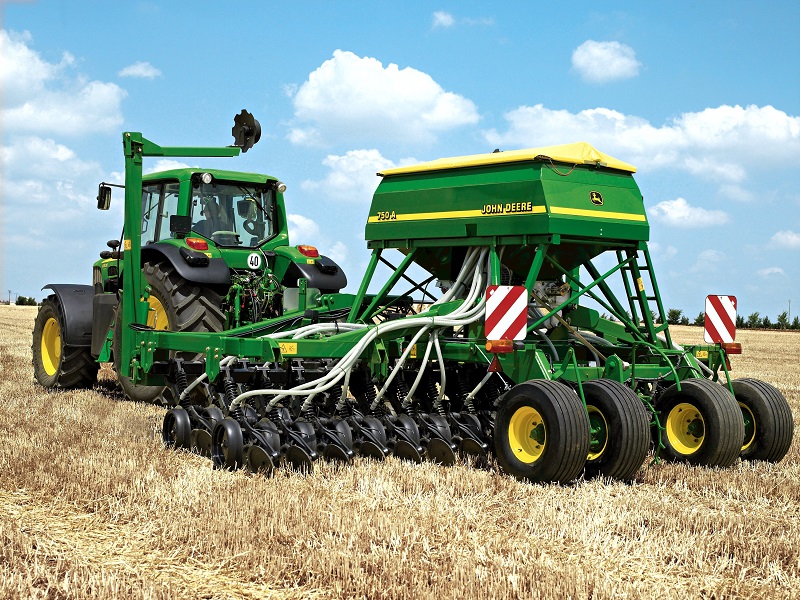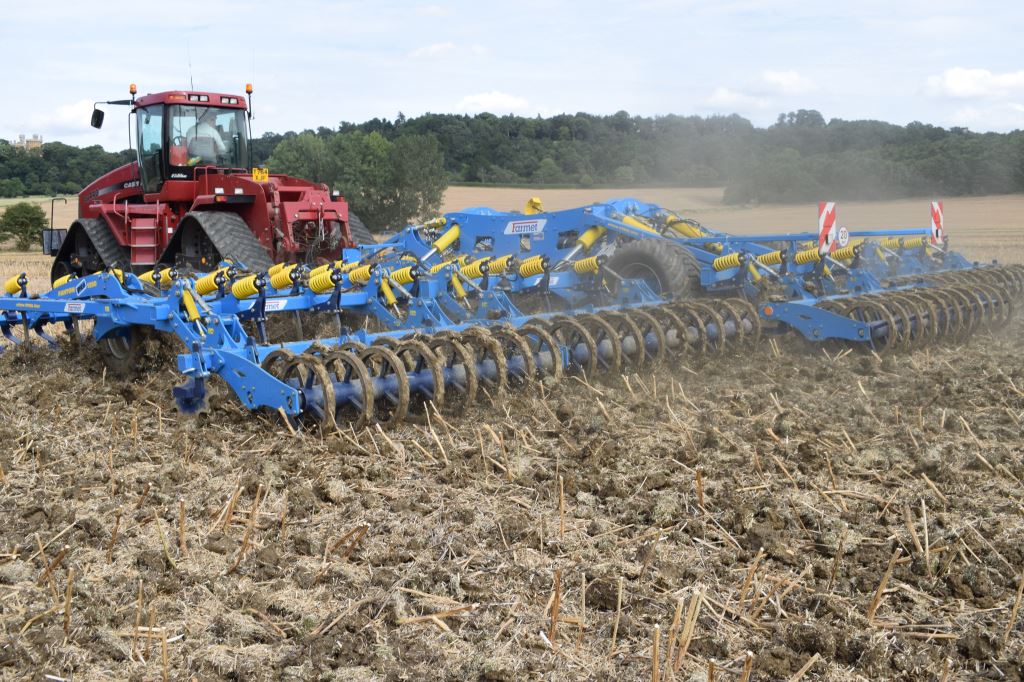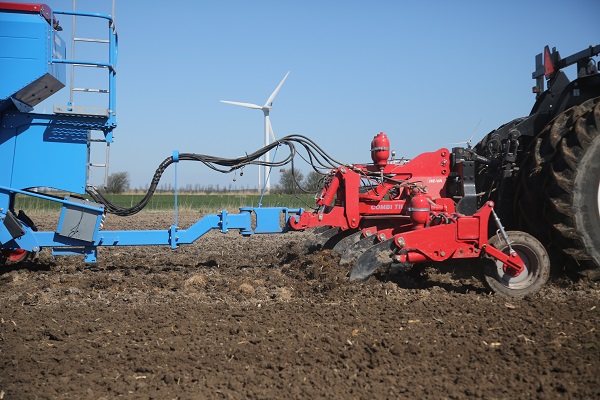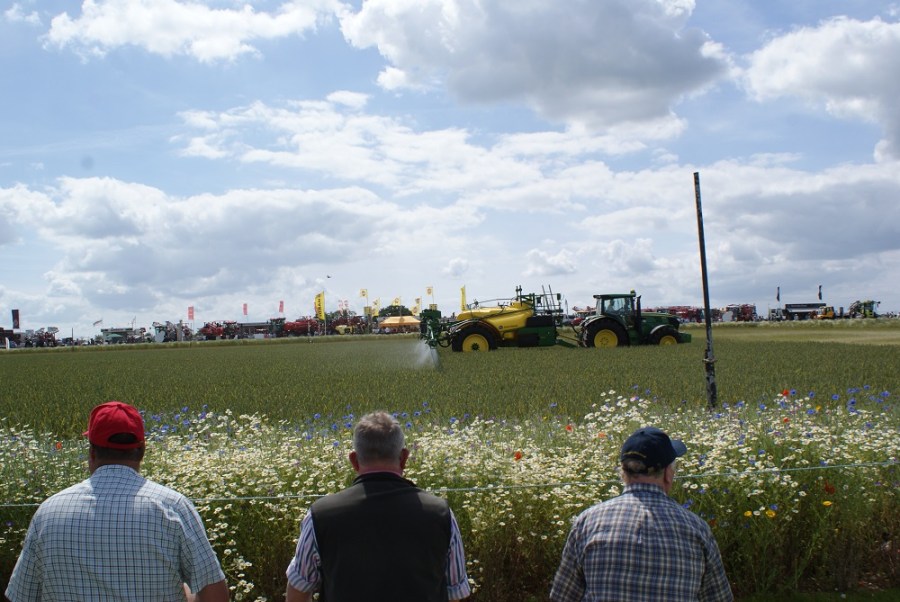From what goes in the ground to what scans from the air, Cereals 2017 is set to have a tempting array of new technology and ideas in its lines. CPM whets the appetite.
One day may not be enough to see everything.
By Jane Brooks
This year’s Cereals event returns to Boothby Graffoe in Lincs on 14 and 15 June. With over 64ha of stands, crop plots; working demonstrations and industry experts also available to give advice, one day may not be enough to see everything.
John Deere’s 400hp 8400R tractor recently set three new world records for fuel efficiency and maximum drawbar performance at the DLG test station in Germany.

The John Deere 750A All-Till drill will be part of the event’s ‘Managing Blackgrass’ Knowledge Trail.
Powered by a new John Deere 9-litre Stage IV compliant engine and featuring an e23 transmission with Efficiency Manager, the 8400R delivers up to 450hp with intelligent power management. It has JDLink telematics, including remote display access and wireless data transfer linked to the MyJohnDeere.com website portal.
John Deere stand 116

The Farmet Fantom range of heavy-duty springtines is suitable for mid to high horsepower tractors, with widths from 6-12m.
Cultivation
Kuhn’s multi-purpose seedbed cultivators the Prolander 6000 (6.0m) and Prolander 7500 (7.5m) fold to a transportation width of 2.83m and feature five rows of tines.
Hydraulically adjustable forward mounted support wheels and a hydraulically adjustable rear levelling board are standard. Various front and rear rollers are available as is an optional hydraulic front levelling board and a rear harrow.
Vibrating S tines (70x12mm) positioned at 155mm intervals can be fitted with 60mm shares for seedbed work, or with 180mm duck-foot shares for surface stubble ploughing.
Rear roller options include a double tube (400mm diameter) and notched (320mm) roller arrangement, or self-cleaning twin U-shaped rollers (both 600mm diameter) spaced at 12.9cm intervals.
The five rows of tines have wide inter-tine and inter-beam clearances and are carried on a frame with 60cm of clearance. There’s a low power requirement (25-35hp per metre of working width) and working speeds of up to 12km/h. Kuhn stand 384.
Väderstad’s new Double SteelRunner soil packer for their Carrier L and XL disc cultivators is already a feature on the TopDown.
The Double SteelRunner ensures cultivated soil dries up faster. The open design of the packer results in minimized bulldozing and a low draught requirement.
Carrier L and XL disc cultivators have 51cm and 61cm diameter notched edged discs respectively, available in 4.25-8.25m working widths.
Discs are interchangeable between Carrier models and tools including straw harrow, CrossCutter Knife and CrossBoard can also be fitted.
The transport wheels can be lowered in the field in wet areas or in shallow cultivation, and working depth is adjustable from the cab. Transport width is 3m and transport height 4m with a working width of over 8m. Väderstad stand 600
He-Va’s new Combi-Lift Pre-Cultivator allows soil loosening at the same time as drilling or cultivating. Designed to subsoil up to 350mm deep, it’s available in 3m, 4m or 6m versions, the Combi-Lift fits directly on the tractor linkage, incorporating a heavy duty rear linkage which can pull another implement behind.

He-Va’s new Combi-Lift Pre-Cultivator allows soil loosening at the same time as drilling or cultivating.
It’s available with standard subsoiling legs and points or ‘low disturbance’ legs. Standard format suits working in combination with shallow cultivators or cultivator drills.
The low disturbance version consists of a narrower leg and a smaller tungsten-tipped point; it can be used down to a depth of 250mm.
Hydraulic two-point linkage on the rear of the Combi-Lift, allows tine working depth adjustment from the tractor seat without affecting the trailing machines drawbar height.
‘Hammer –Thru’ multi-segmented shearbolt or automatic hydraulic reset leg protection is available. The hydraulic reset allows the legs to trip back when they hit an obstacle and then reset automatically on the move. Opico He-Va stand number 3052.
J Brock and Sons have increased the range within their Brock-Ag and Farmet product lines. Derry Morton, sales manager at Brocks says the Farmet Fantom range of heavy-duty springtines are ideal for controlled traffic farming systems.
A large number of closely spaced tines ensure as much of the soil gets moved as possible, while being spaced over many rows to avoid trash blockage. This range is suitable for mid to high horsepower tractors, with widths covered from 6m to 12m.
Brock-Ag’s new trailed subsoiler has a novel unfolding mechanism, allowing working widths of up to 8m while maintaining a narrow and compact transport width. Also, the ability to work with the packer in or out of work gives added flexibility. J. Brock and Sons stand 4000.
Drills
Dale Drills Eco-M drill is available in sizes from 3-6m. The M series mounts the company’s Eco drilling assemblies to a trailed chassis in three rows. Land wheels are positioned between the first and second row while the seed hopper is mounted towards the front of the drill for even weight distribution.
Developments to the Eco-M’s chassis should improve performance by reducing overall weight, creating more room within the drill for trash flow and improving access for calibration and adjustments. Additionally, they now offer three types of following harrow.
The company says it offers a standalone GPS system on its machines, enabling drilling from variable seed rate maps with a non-GPS tractor operating the drill. Dale Drills stand 2039.
John Deere’s versatile 750A All-Till seed drill is available in 3, 4 and 6m versions. It has the Accord air seeding system and is designed with large clearances for no-till drilling into stubble, working after minimum or conventional cultivations, and single-pass operation for grassland and rough pasture renovation.
In operation, the 750A creates minimal soil disturbance outside the small slot created by the single disc on each opener, making it ideal for drilling into stale seedbeds created for blackgrass control, says John Deere.
Sprays and sprayers
Visitors to the Syngenta sprays and sprayers area can see timetabled demonstrations of the latest self-propelled, mounted, trailed, air-assisted and twin-fluid sprayers.
Amazone’s latest 2017 model Pantera 4502 meets Stage IV emission standards using a combination of exhaust gas recirculation, selective catalytic reduction with AdBlue, together with a diesel oxidation catalyst and a diesel particulate filter (DPF).
A new 20-litre AdBlue tank is positioned to the side of the machine’s 230-litre diesel tank. AdBlue use is approximately 2.5% of fuel consumption.
There’s a new tank access ladder on the right-hand side of the machine and LED rear lights. LED work lights instead of the standard Halogen lights are also available.
Suction capacity is now 600 l/min and filling time less than 10 mins. For headland filling, the bowser fill port has moved forwards into the storage compartment beneath the cab and automatic fill stop is standard. Amazone stand 2.
Knight Farm Machinery’s new Xplorer Series 3 trailed sprayers have 3000 or 4000-litre spray tanks and steel booms of 12-28m. Spray tanks are moulded polyethylene and equipped with a remote drain, a 300-400 litre clean water rinse tank and a 40-litre chemical induction hopper fitted with Arag ergonomic control valves.
They offer automatic boom height and levelling, and booms are fitted with 19mm stainless steel spray lines. Triplet or Quin nozzle bodies are available together with a set of fan nozzles.
Joystick operation of boom and spray control together with an Arag Delta 80 terminal enables automatic application rate control, GPS and 3G communication. With EGNOS and RTK receivers, it has DGPS guidance and Seletron auto individual nozzle control.
There’s self-levelling and anti-yaw suspension, a heavy-duty axle and slope and tilt sensing Axle-Trak with an auto steering axle system. Knight Farm Machinery stand 14.
TeeJet Technologies new TTI60 TwinJet spray tip series builds on the drift control of the original TTI spray tip series with the addition of twin spray patterns and a combined tip-cap design.
The TTI60 primarily produces Ultra Coarse and Extremely Coarse droplets across a wide pressure range, providing excellent drift control and produces minimal driftable fines – less than 1.5%. The twin spray patterns provide enhanced coverage and penetration for improved control, says TeeJet, particularly at lower carrier volumes or when dealing with a denser crop canopy. The tip-cap design allows for quicker installation in the field and can be disassembled for cleaning.
TeeJet Technologies DynaJet Flex nozzle control system has new features. Higher frequency, 20Hz solenoid operation ensures thorough spray coverage across a wide range of operating conditions.
Additionally, dual nozzle, high-flow capability significantly expands the overall ground speed and application rate range of the system. New, on-screen diagnostics allow quick, in-cab assessment of solenoid health and operating status.
DynaJet Flex is compatible with air-induction tip technology. Specifically, the TeeJet AITTJ60 Air Induction TwinJet provides excellent spray distribution quality when used with DynaJet. TeeJet Technologies stand 122.
Grimme have their field loader the CleanLoader together with their new loading cart called Crop Cart.
The fully road legal CleanLoader reduces trash content in the field and features four large wheels on a tandem axle. An external power source isn’t needed to operate it due to an on-board 46KW four-cylinder diesel engine. It unfolds and is work ready in 15 mins.
The CleanLoaders output is 120t/hr depending on soil type, crop and working conditions, it can load a 30t potato bulker in 15 mins.
The Crop Cart has a 20t holding capacity, is 12m long and with a 6.5t/min unloading capacity, it handles crops gently and minimises soil compaction, says Grimme. Depending on the attachment the Crop Cart can transport and trans-load most crops including potatoes, sugar beet, grain and carrots.
The boom is designed for high capacity unloading. Grimme stand 376.
Cereals 2017 at a glance
Dates/times: Weds 14 June and Thurs 15 June 8am-6pm. Car park opens at 6:00am
Address: Old Rocket Site, Boothby Graffoe, Lincoln LN5 0AS
Nearest station: Lincoln, St Mary’s Street, Lincoln, LN5 7EW (approx. 10 miles)
Drones – The eye in the sky
Agronomist Sean Sparling, current chairman of the AICC finds his drone useful, although it’s an extra cost, as he doesn’t charge customers for its use. “Initially blackgrass mapping and identifying nutrient deficient areas were my reasons for using a drone – out of my 10,000ha I have about 9300ha of blackgrass,” he explains.
“I daily walk 16-20 miles, but now image quality from a drone is such that it takes a couple of minutes to put it in the air, navigate above a block of 320ha, take a picture and have a look.
“I structure my walks to where the images show me something’s wrong and that’s a massive benefit. I’m still walking the same amount but no longer gambling I’ll walk into a bad area. So it’s a management tool for me, enabling me to be more efficient finding and diagnosing problems within fields.
“Once I hit the middle of April I rarely walk through oilseed rape because it’s not physically possible to do so. Now I can view OSR fields from above to see if blackgrass is flourishing within the canopy.
“Also on new farms I can send it up and get HD photographs of the fields, identifying soil types, drainage issues and weed areas, which is a massive boon.
“I’ve flown drones for 3.5 years and currently have a DJI Mavic Pro, weightng about 1.5kg. The technology is great – it has obstacle avoidance and a very high quality camera, which is important. You can set a geo-wall to stop it going out of an area and hand-fly it home. Of course, I never take it out of eyesight.
“I use it sensibly and have attended a course. I’m always in the middle of nowhere and I use it as I would a very tall ladder, except a ladder’s not so easy to use.”
New Business
First time exhibitor Ben Storer of SkyWrx (stand 918f) provides aerial imagery and surveys, specialising in providing precision farming data.
“I’ve done trials in Lincs to produce data sets enabling me to prepare comparisons of large-scale spraying costs. So I can show customers their potential savings by using the Normalized Difference Vegetation Index (NDVI) maps and shape files I produce.”
He uses a drone-mounted Parrott Sequoia multi-spectral sensor to map the crop, which looks at the four spectral bands (green, red, red-edge and near infrared) and also has an RGB camera.
Pix4D drone mapping software analyses multispectral data, generating index and prescription maps, as well as detailed orthomosaic aerial images of the land and crops.
“Information undergoes office-based analysis to deliver very detailed plans, or, depending on mobile signal on-site processing can produce a basic plan.”
Getting qualified
Warwicks-based UAV Commercial Services provides CAA qualified commercial drone operator (CAA PFCO) training in collaboration with Resource Group (RGL).
“Initially people do ground school first,” says UAV director Allan Ballard. “The cheapest way is a 20-hour eLearning course, which costs £750 culminating in an hour and a half ground school exam.
“Additionally, we offer combined eLearning and two-day classroom-based ground school leading to the exam costing £995. It also takes people through to full CAA qualification, involving producing a drone business operations manual, which goes to the CAA for assessment and a practical flying test.
“A degree of experience, probably 25 flights, is required but there’s more to the test than flying a drone it’s about mitigating risk as well. Allan Ballard advises practicing with an inexpensive micro drone.
The Civil Aviation Authority (CAA), regulates drone use in the UK, currently if you gain a “valuable consideration” from flying a drone then you need a Permission for Commercial Operations document (CAA PFCO).
Jonathan Nicholson from the CAA advises: “if flown within the CAA code it’s not illegal to fly a drone over private property or farmland, however it’s illegal to take off from private property without permission.”
Pulling in the points
Visitors can claim a maximum of six BASIS CPD points per day, two for attendance, (collectable at BASIS stand 420) and four from exhibitor knowledge trails. 20 organisations offer BASIS points. One point can be claimed from each exhibitor.
NRoSO members can claim a maximum six points from the event, two for attendance (collectable at NRoSO stand 128), and four from the trail. Nine exhibitors offer points as part of this year’s trail. Two points can be claimed from each exhibitor.




